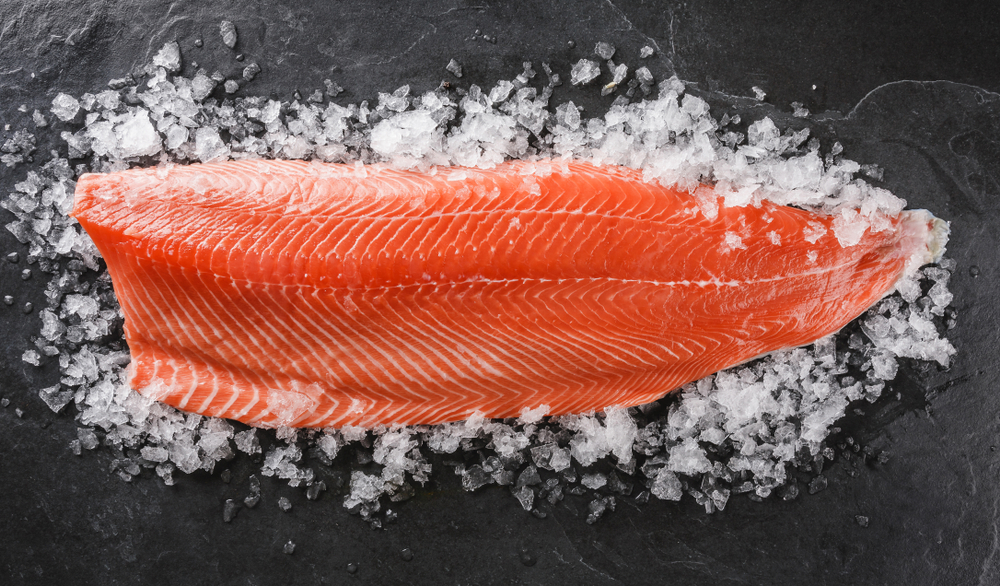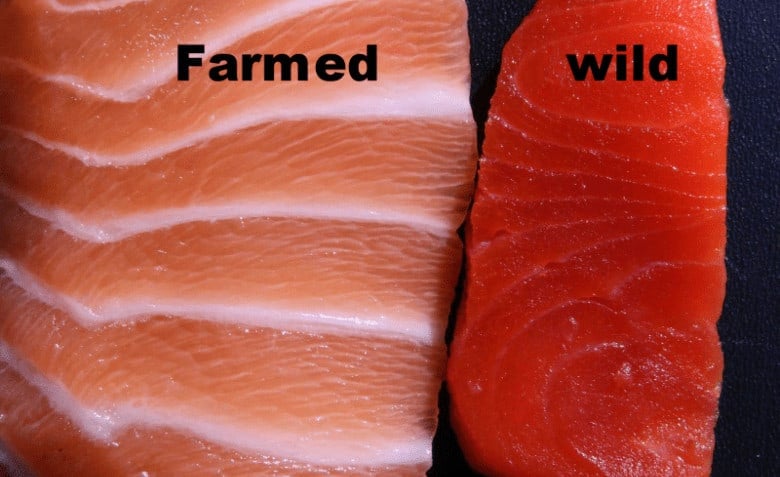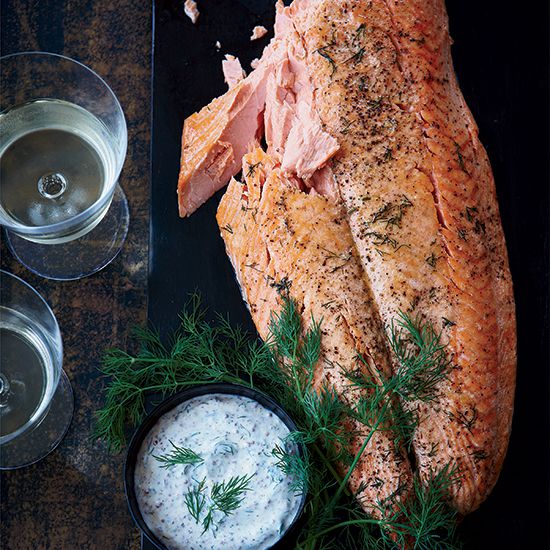Have you ever wondered about the color of farm-raised salmon and how it differs from wild-caught salmon? Understanding the nuances of fish farming practices can provide valuable insights into this industry’s intricacies.
In this blog post, we will delve into the concept of farm-raised salmon color and explore the factors that influence the pigmentation of these aquatic creatures. Let’s uncover the truth behind the hues of farm-raised salmon and gain a deeper understanding of their diet and the additives used in their feed. Join us on a journey of exploration into the world of fish farming practices and discover what goes into achieving that desired pink or orange color in farm-raised salmon.
Introduction To Farm-Raised Salmon Color

Why Farmed Salmon Isn’t Naturally Pink?
Farm-raised salmon wouldn’t be pink if left to their own devices. Their flesh is naturally white. To meet consumer expectations, fish farmers add color additives to their feed. These additives turn the salmon’s flesh pink or reddish, mimicking the color of wild salmon.
Why Color Matters to Salmon Farmers?
The color of farm-raised salmon is crucial for consumer satisfaction. People expect salmon to be pink, so that’s what farmers aim for. By adding coloring compounds like astaxanthin to the fish feed, they achieve this desired hue. This process ensures a visually appealing product that aligns with market demands.
Factors Affecting Farm-Raised Salmon Color
Several factors influence the final color of farm-raised salmon:
- Diet: The type and amount of pigments in the salmon’s feed significantly affect the intensity and shade of its flesh.
- Astaxanthin Levels: This natural pigment, found in algae and crustaceans, is commonly added to salmon feed. The amount of astaxanthin directly impacts the final flesh color.
- Genetics: Different salmon species and strains have varying abilities to absorb and store pigments in their flesh.
- Light Exposure: Light can influence how salmon develop pigmentation. Fish farms often use controlled lighting conditions to manage this process.
By carefully managing these factors, farmers ensure their salmon achieves the same appealing pink color as wild-caught fish.
Farm-Raised Salmon: Color and Nutrition through Farming Practices

Farm-raised salmon’s vibrant color isn’t just a coincidence! Farming practices significantly impact the hue of the fish. Farmers control what salmon eat, allowing them to tailor the fish’s diet for optimal health and a visually appealing appearance. This translates to a more consistent and desirable color for consumers.
The secret lies in carefully chosen additives. Farmers include natural pigments in the salmon’s feed, mimicking the colors they would get from their diet in the wild. This ensures consistent coloration without resorting to artificial coloring. Additionally, strict farming standards prioritize sustainable practices, allowing salmon to retain their natural beauty while meeting regulations.
The benefits of controlled feeding go beyond aesthetics. By meticulously managing the salmon’s diet, farmers provide them with a balanced and nutritious feast. This allows for the inclusion of ingredients that boost omega-3 fatty acids, renowned for their health benefits. Plant-based ingredients rich in antioxidants and vitamins are also incorporated, further enhancing the fish’s overall nutritional profile.
Controlled feeding techniques optimize the nutritional content of salmon feed. This results in healthier fish packed with more nutrients for you to enjoy. So, the next time you savor some salmon, remember the science behind its vibrant color and impressive nutritional value!
Farm-Raised Salmon: Balancing Color and Sustainability

Farm-raised salmon often have a paler color compared to their wild counterparts. This difference raises several challenges for salmon farmers.
The Issue of Artificial Coloring
Some salmon farms use synthetic pigments to achieve a more vibrant color. This practice raises concerns:
- Health Impacts: The long-term effects of these additives on both fish and consumers are still under investigation.
- Ethical Considerations: The use of artificial coloring creates questions about the naturalness of the product and transparency for consumers.
Environmental Influences on Color
Wild salmon get their pink color from a natural pigment called astaxanthin, found in their diet of krill and shrimp. In contrast, farm-raised salmon often lack these natural food sources, leading to paler flesh.
Striking a Balance
Salmon farmers face a constant challenge: meeting consumer preferences for a bright, appealing color while maintaining ethical and sustainable practices. Achieving a natural-looking color without compromising fish health, the environment, or consumer trust remains an ongoing pursuit.
Regulations and Labeling for Safe, Sustainable Farm-Raised Salmon
Regulations and labeling standards are essential for high-quality, safe, farm-raised salmon. Government agencies set rules for salmon farming practices and the use of coloring agents. These rules protect both consumers from harmful substances and the product’s integrity.
Color additives used in salmon farming undergo strict approval procedures to guarantee their safety. Additionally, labels clearly disclose their use, allowing consumers to make informed choices.
Certifications like the Aquaculture Stewardship Council (ASC) and Best Aquaculture Practices (BAP) ensure sustainable and responsible salmon farming. Look for these logos on packaging to make environmentally conscious choices. Labels also provide transparency by detailing the salmon’s origin and any color additives used.
By adhering to these regulations and standards, the salmon farming industry builds consumer trust and delivers safe, responsibly sourced fish.
Consumer Preferences for Farm-Raised Salmon Color

Consumers play a significant role in shaping the demand and preferences for farm-raised salmon. When it comes to color, there’s no one-size-fits-all answer.
Some consumers prefer a natural, reddish-pink color because it resembles wild salmon. They associate this color with higher quality and more nutrients. For them, it’s a sign the salmon was fed a healthy diet rich in astaxanthin, an antioxidant.
However, other consumers are less concerned about color. They prioritize factors like taste, texture, and price.
Ultimately, how consumers perceive and understand salmon color shapes their choices in the marketplace.
Conclusion
Farm-raised salmon’s vibrant color isn’t just for show! It’s influenced by a combination of factors like what the fish eat, how they’re raised, and even the environment they live in. By carefully controlling their diet and farming techniques, producers can ensure consistent color and improve the nutritional value of salmon fillets.
However, there are hurdles to overcome. Using artificial coloring and dealing with environmental factors can make it challenging to maintain natural coloration. Here’s where government regulations and certifications come in – they play a vital role in guaranteeing responsible farming practices and clear labeling.
Consumers also play a part! Their preferences for natural or enhanced color affect the market demand for farm-raised salmon. As research and advancements in farming techniques continue, the future of salmon coloration looks bright.
Impact of Farming Practices on Salmon Color
Farming practices significantly impact the color of farm-raised salmon. By controlling what the fish eat and how they’re raised, producers can achieve consistent color and even boost the nutritional value of the salmon. However, challenges, like the use of artificial coloring and environmental factors, can affect natural color development.
Just like with responsible farming practices, clear labeling standards are crucial, ensured by government regulations and certifications. Additionally, consumer preferences for natural or enhanced color influence how much farm-raised salmon is demanded. With ongoing advancements in farming techniques, the future of salmon coloration in the industry looks promising.
Future of Salmon Farming and Coloration Techniques
The future of salmon farming and coloration techniques is all about finding innovative ways to enhance the natural color of farm-raised salmon. Researchers are exploring the use of natural pigments from plants to improve the color consistency and quality of salmon fillets. Sustainable practices, like optimizing feed formulations and controlling water quality, are also being prioritized to maintain vibrant colors.
Exciting advancements are even being made in genetic selection and breeding programs to create salmon with naturally superior color. These ongoing efforts hold promise for the future of salmon farming, ensuring that farm-raised salmon continues to be a colorful and healthy option for consumers.
References:
FAQ about Farm Raised Salmon Color: Understanding Fish Farming Practices
Q: What influences the color of farm-raised salmon?
A: The color of farm-raised salmon is primarily determined by their diet, which often includes pigments added to the feed to achieve desired hues.
Q: Are the pigments in salmon feed safe for consumption?
A: Yes, regulatory authorities have approved the pigments used in salmon feed for use in aquaculture, ensuring their safety for consumption.
Q: How do government regulations and certifications impact salmon farming practices?
A: Government regulations and certifications play a key role in ensuring responsible farming practices, labeling standards, and consumer trust in the industry.
Q: What role do consumer preferences play in the market demand for farm-raised salmon color?
A: Consumer preferences for natural or enhanced color influence the market demand for farm-raised salmon, shaping industry practices and product offerings.
Q: How will further research and advancements in salmon farming techniques impact the coloration of farm-raised salmon?
A: Ongoing research and advancements in salmon farming techniques will continue to drive innovations in coloration, shaping the future of farm-raised salmon in the industry.

Welcome to Braddock Bay Tavern & Grill, where history, delicious cuisine, and stunning views come together to create an unforgettable experience. Our restaurant, situated on the picturesque edge of Lake Ontario, has a rich history that adds a unique charm to your dining experience. The roots of our establishment can be traced back to 1865, when it was first constructed as an icehouse. Over the years, it transformed into the historic Braddock Bay Hotel, becoming a beloved local landmark. Today, we take pride in preserving the building’s historical beauty, ensuring that every visit to our restaurant is a journey through time.